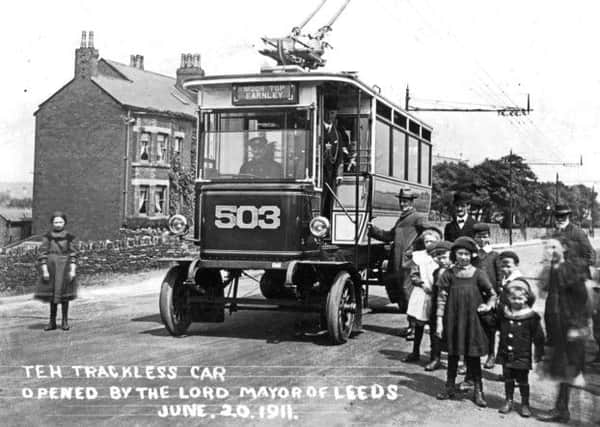When Leeds transport was like riding on the back of a pig


The first trackless car was introduced in Leeds to appease residents in Farnley who had long campaigned for a tram service. Prior to this, trams had been thought to be economically unviable.
Then on the continent, came an innovative form of transport – railless traction. Vehicles collected power from overhead, similar to trams, but there were no rails. The trolleybuses or tracklesses, as they came to be known, were steered like a bus.
Advertisement
Hide AdAdvertisement
Hide AdAround 1909 the Leeds Tramways Committee was curious about this new development, and a sub-committee was despatched to visit Vienna and Milan where railless traction systems were employed. Members were impressed with the “smoothness and comfort”. A little later, Bradford Corporation also sent a deputation abroad.
In Leeds, following several meetings and motions, an application for authorisation to run trolleybuses was ready to be submitted to Parliament. A proposed route would run from City Square, via Wellington street, Aire Street and Whitehall Road with a terminus at Farnley Moor Top. One of the points in favour of a trackless system was the significant saving in the setting up costs over trams.
During April 1910 two Trolleybus Bills – one from Leeds and another from Bradford – were approved by MPs.
Initially, four vehicles were ordered by Leeds. The chassis manufacturer was the Railless Electric Traction Company and the bodies were made by the Hurst, Nelson company.
Advertisement
Hide AdAdvertisement
Hide AdSeating 28 passengers, the vehicles had a front entrance. The wheels had solid rubber tyres, four at the back and two at the front.
The Leeds and Bradford trackless systems, the first in the UK, were planned to be opened together on June 20, 1911. On the following day The Yorkshire Post reported that it was arranged that the inaugural trip should start from City Square. But, it was decided at the last moment that as a large crowd might considerably impede traffic at this point it would be better that the assembly of guests should take place in some less frequented thoroughfare.
Thus, two vehicles were drawn up in Thirsk Row. The Lord Mayor, William Middlebrook, MP, was in one car and Alderman Kitson in the other. Afterwards, councillors and dignitaries attended a luncheon in the Town Hall and Sir William Clegg, chairman of the Sheffield Tramways Committee, toasted the success of trailless traction.
Regular passenger services began in Bradford and Leeds simultaneously on June 24, 1911. An hourly service was run from Leeds City Square to Farnley for a fare of 3d. After initial success, deputations from around the country and abroad arrived to inspect them.
Advertisement
Hide AdAdvertisement
Hide AdTravelling at about 16mph, trolleybuses on the Leeds route took about an hour for the journey.
By November 1912, Leeds had submitted proposals to Parliament for seven more trackless routes, but only two opened – Guiseley to Otley and Guiseley to Burley-in-Wharfdale. Bradford also gained powers for an ambitious scheme of trackless extensions.
Some regarded the Leeds trolleybuses as ugly, noisy and nerve-wracking. In an attempt to stop them splashing mud on everyone owing to the poor condition of the roads, large, unsightly mudguards were fitted.
Jim Soper in Leeds Transport Volume 2 states that spare parts were difficult to obtain during the First World War and Wharfedale Rural Council reported that £2,000 damage had been caused to the area’s roads.
Advertisement
Hide AdAdvertisement
Hide AdOn March 14 1921 The Yorkshire Post reported that many complaints had been made about constant breakdowns and delays and the discomfort of travelling on bad roads.
Despite these problems, a new double-deck trolleybus was introduced by Leeds. A further batch of similar vehicles was built, but all the Leeds trolleys had been removed from service by 1929.
Ex staff, interviewed by A.D. Young and Jim Soper, said the cars, running on lightly trafficked routes, nearly always operated at a loss. Motorbus competition increased this.
However, in Bradford the system was further developed and modernised and survived, the last one running in 1972.